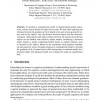Free Online Productivity Tools
i2Speak
i2Symbol
i2OCR
iTex2Img
iWeb2Print
iWeb2Shot
i2Type
iPdf2Split
iPdf2Merge
i2Bopomofo
i2Arabic
i2Style
i2Image
i2PDF
iLatex2Rtf
Sci2ools
NLUCS
2008
2008
The Role of Attention in Understanding Spatial Expressions under the Distractor Condition
Abstract. To develop a computational model of understanding spatial expressions, various factors should be taken into account. We have been exploring the relations between the goodness-of-fit of spatial terms and various geometric factors such as the object's size, the distance between objects and the observers' viewpoint. Although the dual-object relation between the located and reference objects can be handled with relatively simple models, introducing a distractor object requires a model considering further factors to explain relations, such as attention to the objects. Based on our experiment using Japanese topological and projective terms, this paper proposes a computational model to estimate the goodness-of-fit of spatial terms which incorporates an attention model for a distractor object. The proposed model was evaluated by using our experimental data.
| Added | 30 Oct 2010 |
| Updated | 30 Oct 2010 |
| Type | Conference |
| Year | 2008 |
| Where | NLUCS |
| Authors | Tatsumi Kobayashi, Asuka Terai, Takenobu Tokunaga |
Comments (0)

